BUFFALO 000000017 AirStation User Manual WI U2 433DM WI U2 300D
BUFFALO INC. AirStation WI U2 433DM WI U2 300D
BUFFALO >
Contents
User Manual.pdf

User Manual
AirStation
WI-U2-433DM
WI-U2-300D
www.buffalotech.com
3501xxxx-01

1
Contents
Chapter 1 Product Overview ............................................3
System Requirements ..........................................................................3
Package Contents .................................................................................4
Hardware Overview .............................................................................4
Chapter 2 Installation ........................................................5
Installing Wireless Drivers ...................................................................5
Chapter 3 Connect to a Wireless Network .......................8
Windows 8 (WLAN AutoCong) ..........................................................8
Windows 7 (WLAN AutoCong) ..........................................................9
Windows Vista (WLAN AutoCong) ..................................................11
Windows XP (Wireless Zero Conguration) .....................................13
Chapter 4 Trouble Shooting ............................................14
The Computer does not Recognize the Wireless Adapter. ..............14
You Cannot Connect to the Network Wirelessly. .............................14
You Forgot the AP’s SSID, Encryption Key, or Password. ................14

2
Chapter 5 Appendix ........................................................15
Specications .....................................................................................15
WI-U2-433DM ................................................................................................15
WI-U2-300D ...................................................................................................16
Uninstalling the Drivers.....................................................................17
TCP/IP Settings ...................................................................................18
Windows 8 .....................................................................................................18
Windows 7 .....................................................................................................19
Windows Vista ...............................................................................................20
Windows XP ...................................................................................................21

3
Chapter 1 Product Overview
System Requirements
Computer should be IBM/PC compatible with a USB 2.0 port and a CD-ROM drive.
Notes:
This product does not support computers equipped with dual processors (computers with two physical CPUs).
Computers with Dual-core CPU’s are supported.
AirStation does not support Windows Vista (32-bit) standby mode.
Compatible OS
Windows 8 (64-bit or 32-bit), Windows 7 (64-bit or 32-bit), Windows Vista (64-bit or 32-bit), Windows XP (32-bit)
Notes:
Service Pack 2 or later is required for Windows XP.
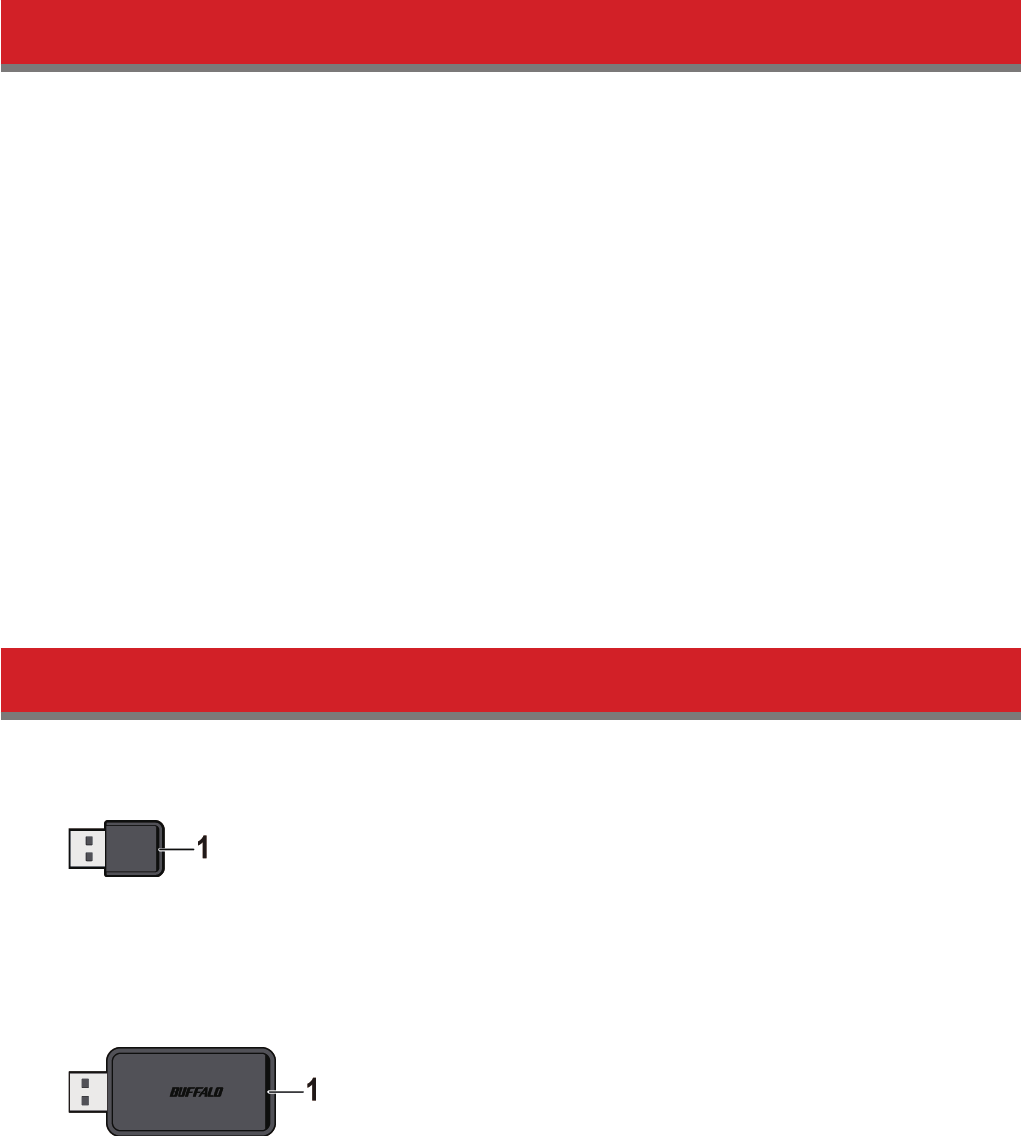
4
Package Contents
The following items are included with your AirStation. If any of the items are missing, please contact your vender.
WI-U2-433DM
• WI-U2-433DM................................................................................................................................... 1
• AirStation Driver CD....................................................................................................................... 1
• Quick Setup Guide.......................................................................................................................... 1
• Warranty Statement....................................................................................................................... 1
WI-U2-300D
• WI-U2-300D....................................................................................................................................... 1
• AirStation Driver CD....................................................................................................................... 1
• USB cable............................................................................................................................................ 1
• Clip........................................................................................................................................................ 1
• Quick Setup Guide.......................................................................................................................... 1
• Warranty Statement....................................................................................................................... 1
Hardware Overview
WI-U2-433DM
1 Activity LED (blue)
Flashes when sending or receiving data.
WI-U2-300D
1 Activity LED (blue)
Flashes when sending or receiving data.
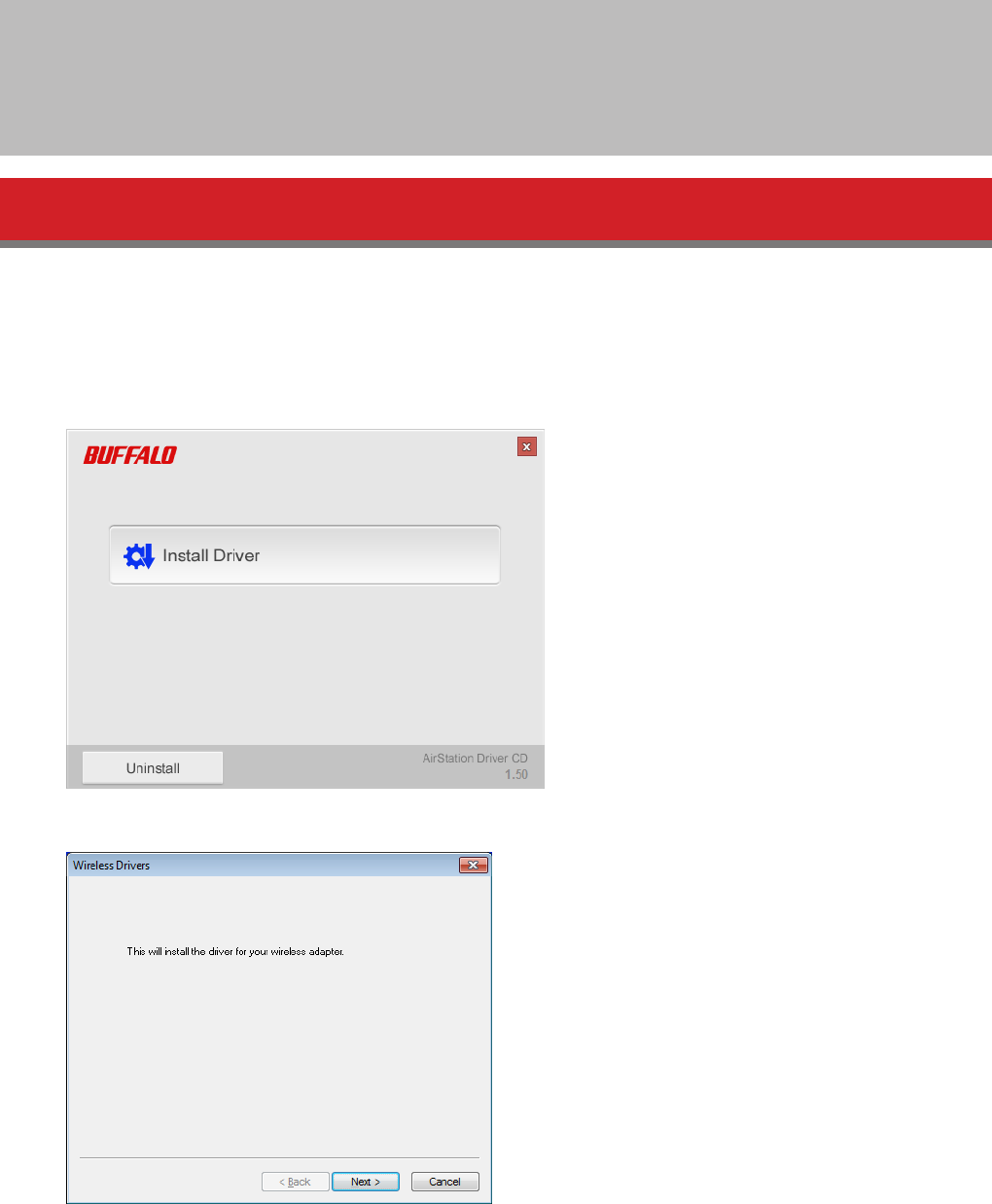
5
Chapter 2 Installation
Installing Wireless Drivers
Follow the instruction below to install drivers. Do not connect the AirStation to your computer yet.
1 Boot your computer and insert the AirStation Driver CD.
The setup menu will launch automatically. If not, open the CD and click “Launcher.exe”.
2 Click [Install Driver].
3 Click [Next].
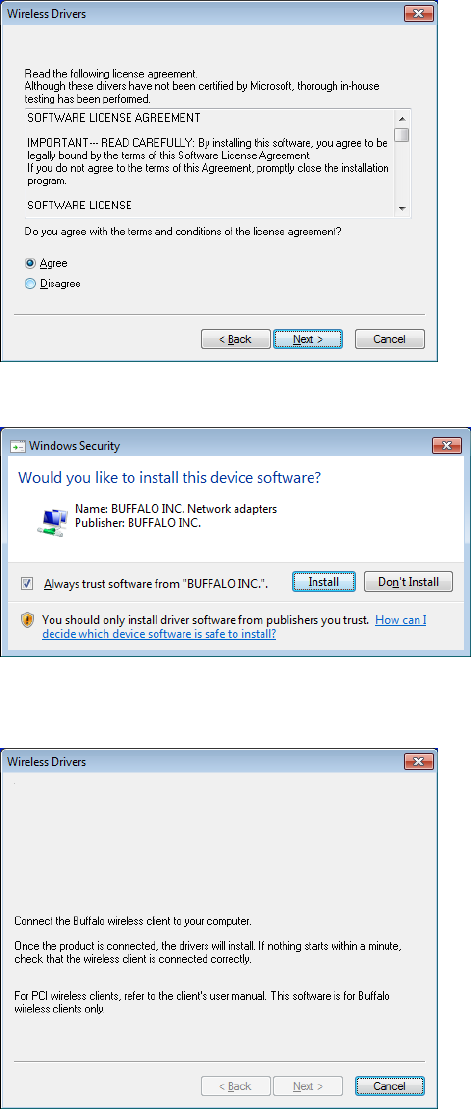
6
4 Read the license agreement, select [Agree], then click [Next].
5 Check “Always trust software from “BUFFALO INC.”, and click [Install].
6 When the screen below is displayed, attach the AirStation to your computer.
Drivers will be installed automatically.
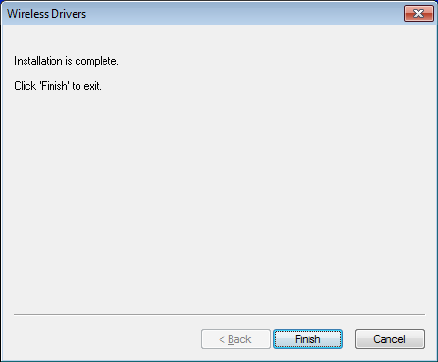
7
7 After the drivers are installed, the screen below will be displayed. Click [Finish].
Drivers are now installed.
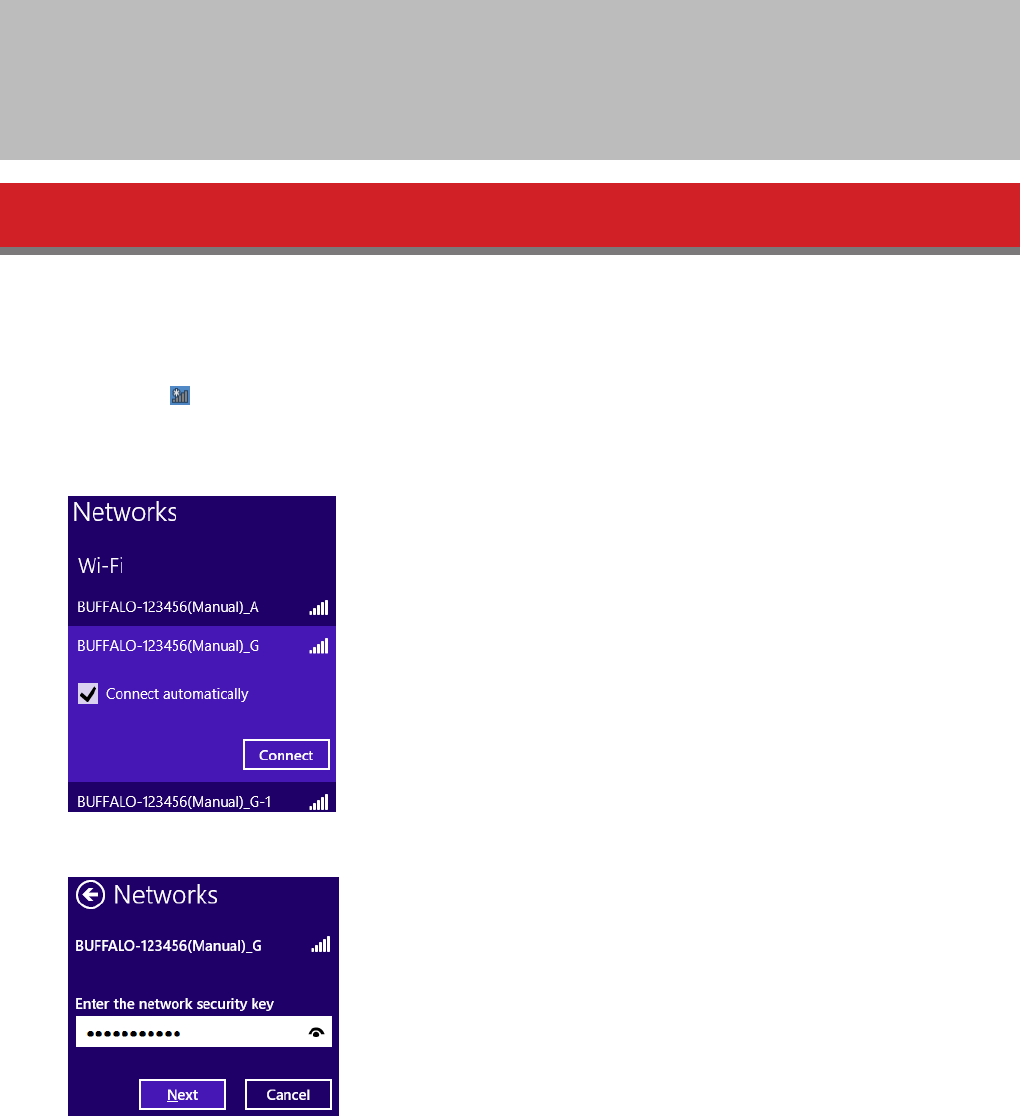
8
Chapter 3 Connect to a Wireless Network
Windows 8 (WLAN AutoConfig)
With Windows 8, use WLAN AutoConfig to connect to the AirStation.
1 Switch Windows 8 to desktop mode.
2 Click on the network icon in the system tray.
3 Select the target AirStation’s name and click [Connect]. If you will be connecting to this device again, check
[Connect automatically].
4 Enter the encryption key and click [Next].
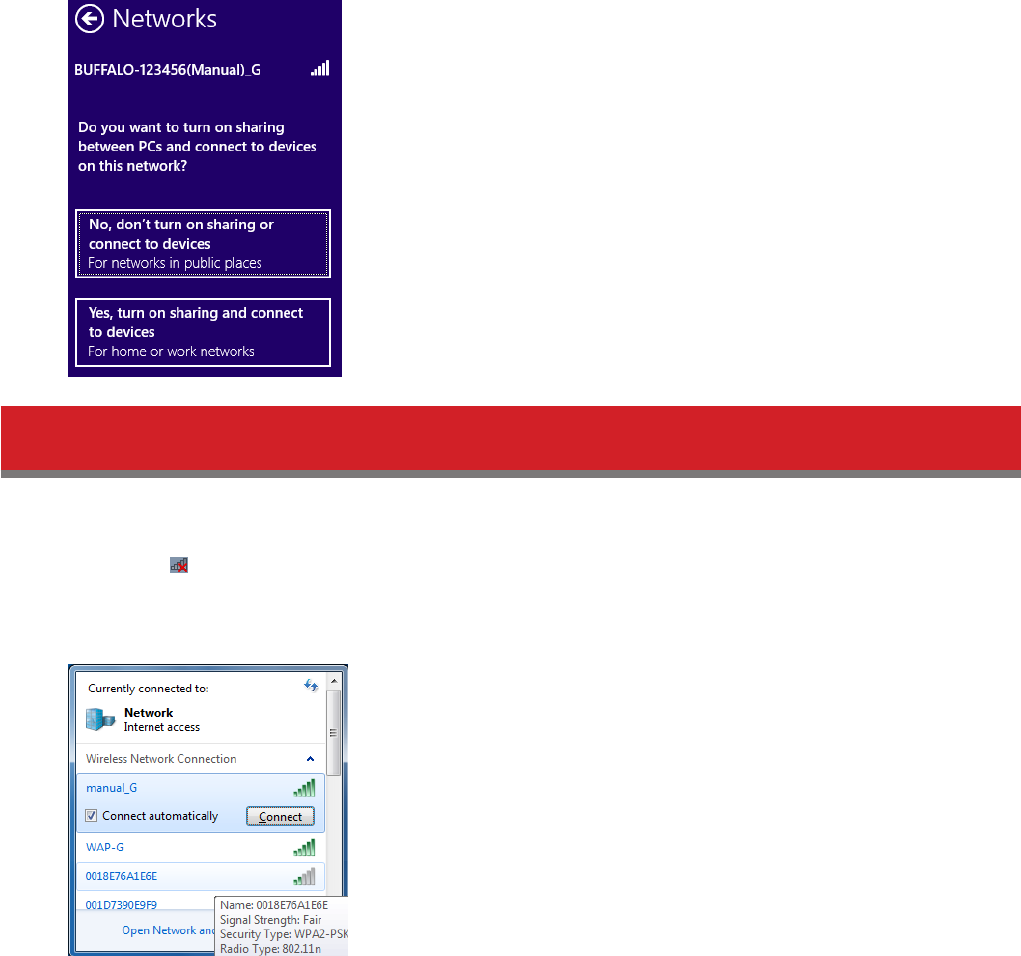
9
5 Click [No, don’t turn on sharing or connect to devices].
Windows 7 (WLAN AutoConfig)
With Windows 7, use WLAN AutoConfig to connect to the AirStation.
1 Click on the network icon in the system tray.
2 Select the target AirStation’s name and click [Connect]. If you will be connecting to this device again, check
[Connect automatically].
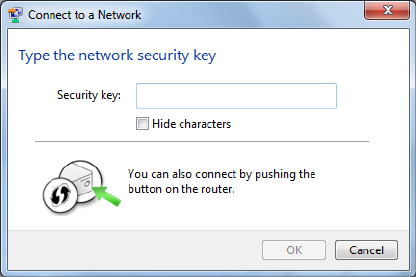
10
3 Enter the encryption key and click [OK].
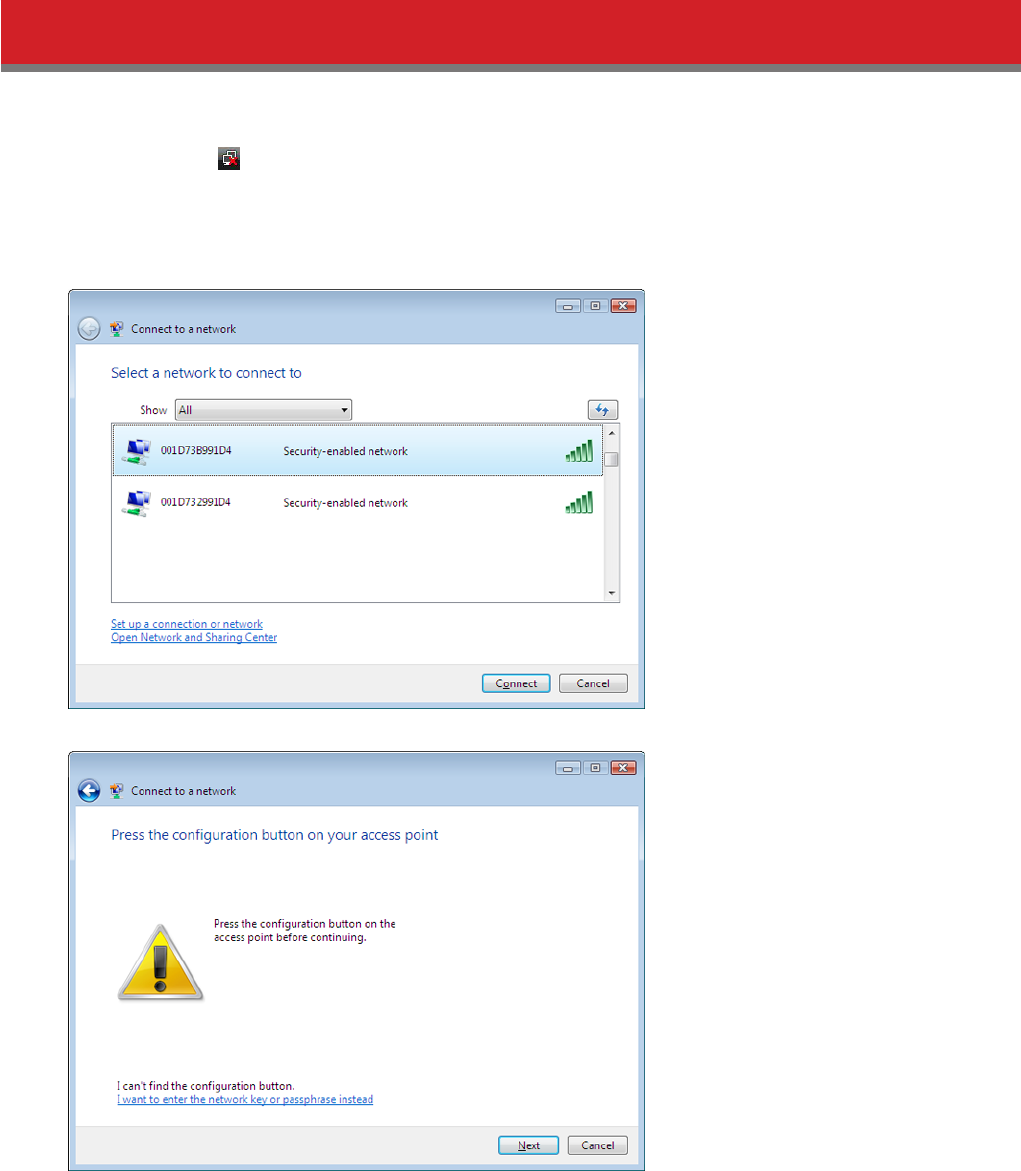
11
Windows Vista (WLAN AutoConfig)
You can use WLAN AutoConfig to connect to a wireless access point:
1 Right-click on the wireless network icon in the system tray.
2 Click [Connect to a network].
3 Select your wireless network and click [Connect].
If the screen below is displayed, click [I want to enter the network key or passphrase instead]. Go to step 4.
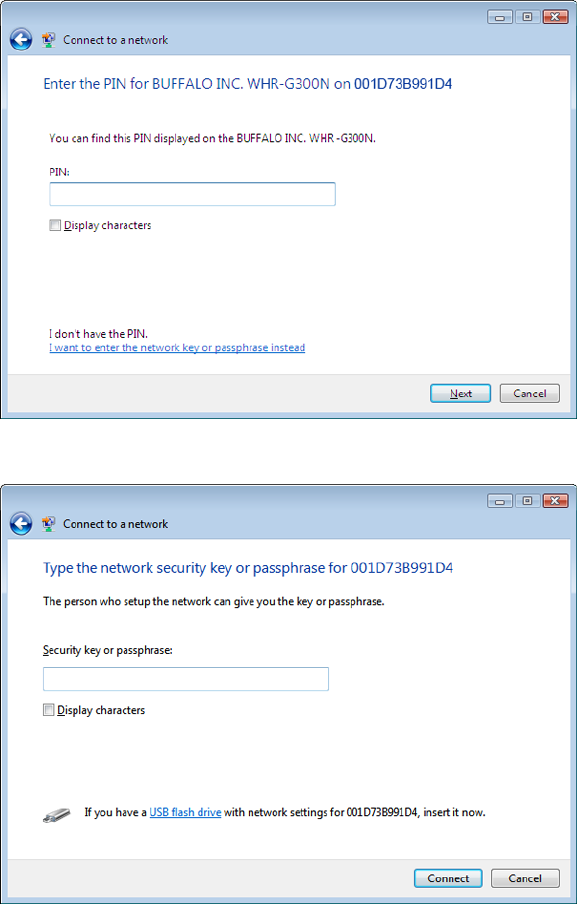
12
4 Enter the encryption key and click [Connect].
Step through the wizard to complete configuration. If the “Set Network Location” screen is displayed, select “Home”,
“Work”, or “Public location” depending where you’re using the AirStation.
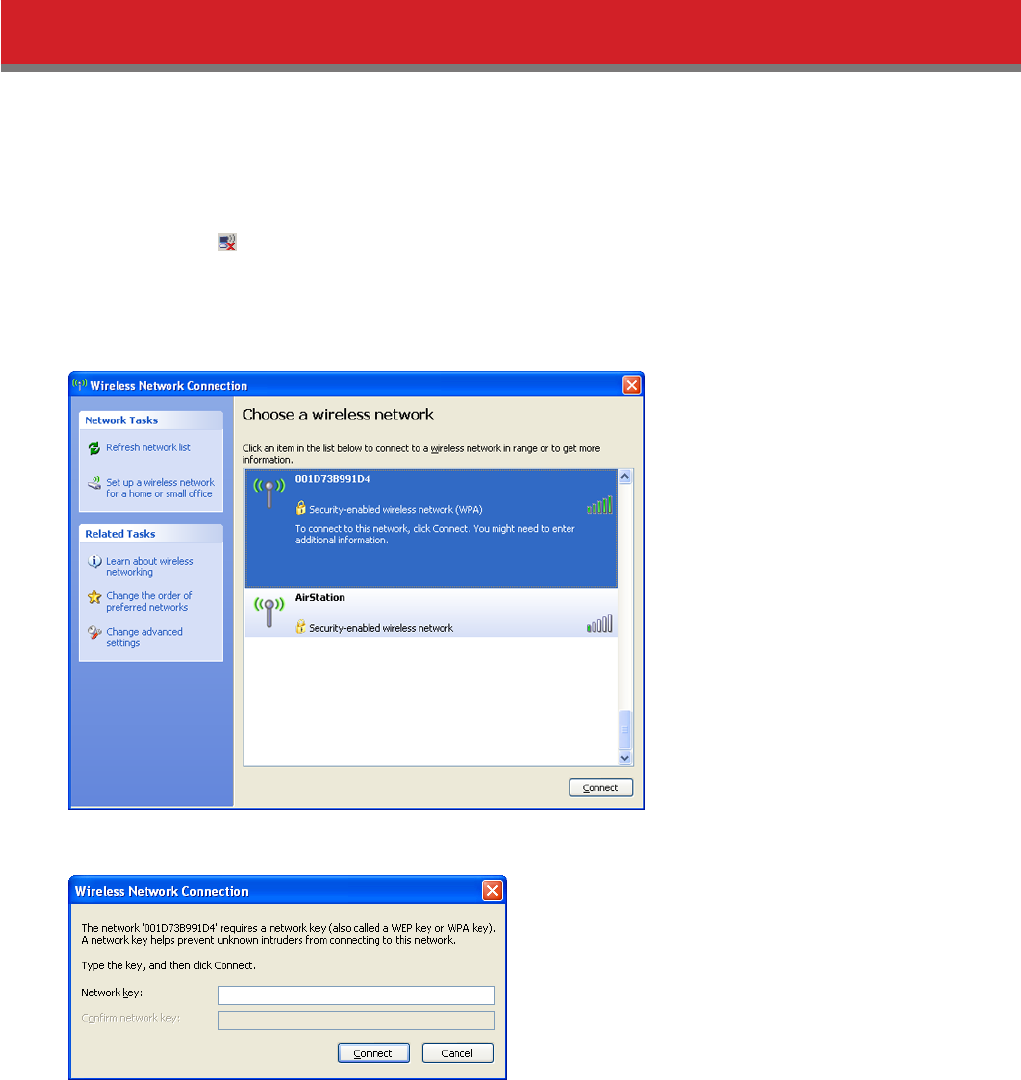
13
Windows XP (Wireless Zero Configuration)
Windows XP includes a built-in utility to connect to your wireless Access Point.
Note:
If Client Manager 3 is installed on your computer, then Wireless Zero Configuration is disabled. Uninstall Client
Manager 3 to use Wireless Zero Configuration, or just use Client Manager 3 to connect to the AirStation.
1 Right-click on the wireless network icon in the system tray.
2 Click [View Available Wireless Networks].
3 Select a wireless network, then click [Connect].
4 Enter the encryption key (passphrase) twice, then click [Connect].
When the connection is complete, the word “Connected” will be displayed to the right of the network’s SSID. Click the “X”
in the top right corner of the window to close the utility.

14
Chapter 4 Trouble Shooting
The Computer does not Recognize the Wireless Adapter.
• Make sure that the Wireless Adapter is connected to a USB port on your computer.
• If your computer has multiple USB ports, connect to a different USB port.
• Refer to chapter 2 to reinstall drivers for this unit.
You Cannot Connect to the Network Wirelessly.
• Refer to chapter 3 to connect the Wireless Adapter to an access point wirelessly.
• Configure the same SSID, encryption method, and encryption key for each wireless device. These settings must match
those of your wireless access point.
• Move your wireless devices closer to the access point.
Restart your access point.
You Forgot the AP’s SSID, Encryption Key, or Password.
Ask your network administrator about your SSID and encryption settings. These settings must match the SSID and
encryption settings of the access point.

15
Chapter 5 Appendix
Specifications
WI-U2-433DM
Wireless LAN Interface
Standard Compliance IEEE802.11ac (Draft 2.0) / n / a / g / b
Transmission Method Direct Sequence Spread Spectrum (DSSS), OFDM, MIMO
Frequency Range Available frequencies depend on the country of purchase. See
the next page for details.
Transmission Rate
802.11ac (Draft)
802.11ac (Draft) 20 MHz BW (Long GI):
78, 65, 58.5, 52, 39, 26, 19.5, 13, 6.5 Mbps (1 stream)
802.11ac (Draft) 20 MHz BW (Short GI):
86.7, 72.2, 65, 57.8, 43.3, 28.9, 21.7, 14.4, 7.2 Mbps (1 stream)
802.11ac (Draft) 40 MHz BW (Long GI):
180, 162, 135, 121.5, 108, 81, 54, 40.5, 27, 13.5 Mbps (1 stream)
802.11ac (Draft) 40 MHz BW (Short GI):
200, 180, 150, 135, 120, 90, 60, 45, 30, 15 Mbps (1 stream)
802.11ac (Draft) 80 MHz BW(Long GI):
390, 351, 292.5, 263.3, 234, 175.5, 117, 87.8, 58.5, 29.3 Mbps (1
stream)
802.11ac (Draft) 80 MHz BW(Short GI):
433.3, 390, 325, 292.5, 260, 195, 130, 97.5, 65, 32.5 Mbps (1
stream)
Transmission Rate
802.11n / a/ g / b
802.11n 20 MHz BW (Long GI):
65, 58.5, 52, 39, 26, 19.5, 13, 6.5 Mbps (1 stream)
802.11n 20 MHz BW (Short GI):
72.2, 65, 57.8, 43.3, 28.9, 21.7, 14.4, 7.2 Mbps (1 stream)
802.11n 40 MHz BW (Long GI):
135, 121.5, 108, 81, 54, 40.5, 27, 13.5 Mbps (1 stream)
802.11n 40 MHz BW (Short GI):
150, 135, 120, 90, 60, 45, 30, 15 Mbps (1 stream)
802.11a / g:
54, 48, 36, 24, 18, 12, 9, 6 Mbps
802.11b:
11, 5.5, 2, 1 Mbps
Access Mode Infrastructure Mode
Security WPA2 (TKIP/AES), WPA-PSK (TKIP/AES), 128/64bit WEP
Other
Power Supply 5.0 V Bus powered
Power Consumption 2500 mW (Max)

16
Dimensions 32.4 mm x 17.6 mm x 7.7 mm (1.28 x 0.69 x 0.3 inch)
Weight 4 g (0.14 ounces)
Operating Environment 0 - 40° C (32 - 104° F) , 10-85 % (non-condensing)
802.11a Frequency Range
USA
Canada
Mexico
5180-5240 MHz (Channels 36, 40, 44, 48)
5260-5320 MHz (Channels 52, 56, 60, 64)
5500-5700 MHz (Channels 100, 108, 112, 116, 120, 124, 128, 132,
136, 140)
5745-5825 MHz (Channels 149, 153, 157, 161, 165)
802.11g Frequency Range
USA
Canada
Mexico
2412-2462 MHz (Channels 1, 2, 3, 4, 5, 6, 7, 8, 9, 10, 11)
WI-U2-300D
Wireless LAN Interface
Standard Compliance IEEE802.11n / a / g / b
Transmission Method Direct Sequence Spread Spectrum (DSSS), OFDM, MIMO
Frequency Range Available frequencies depend on the country of purchase. See
the next page for details.
Transmission Rate
802.11n 20 MHz BW (Long GI):
130, 117, 104, 78, 52, 39, 26, 13 Mbps (2 streams)
65, 58.5, 52, 39, 26, 19.5, 13, 6.5 Mbps (1 stream)
802.11n 20 MHz BW (Short GI):
144.4, 130, 115.5, 86.7, 57.8, 43.3, 28.9, 14.4 Mbps (2 streams)
72.2, 65, 57.8, 43.3, 28.9, 21.7, 14.4, 7.2 Mbps (1 stream)
802.11n 40 MHz BW (Long GI):
270, 243, 216, 162, 108, 81, 54, 27 Mbps (2 streams)
135, 121.5, 108, 81, 54, 40.5, 27, 13.5 Mbps (1 stream)
802.11n 40 MHz BW (Short GI):
300, 270, 240, 180, 120, 90, 60, 30 Mbps (2 streams)
150, 135, 120, 90, 60, 45, 30, 15 Mbps (1 stream)
802.11a / g:
54, 48, 36, 24, 18, 12, 9, 6 Mbps
802.11b:
11, 5.5, 2, 1 Mbps
Access Mode Infrastructure Mode
Security WPA2 (TKIP/AES), WPA-PSK (TKIP/AES), 128/64bit WEP
Other
Power Supply 5.0 V Bus powered
Power Consumption 2500 mW (Max)
Dimensions 73.4 mm x 26.4 mm x 13.2 mm (2.89 x 1.04 x 0.52 inch)
Weight 18 g (0.63 ounces)
Operating Environment 0 - 40° C (32 - 104° F) , 10-85 % (non-condensing)
802.11a Frequency Range

17
USA
Canada
Mexico
5180-5240 MHz (Channels 36, 40, 44, 48)
5260-5320 MHz (Channels 52, 56, 60, 64)
5500-5700 MHz (Channels 100, 108, 112, 116, 120, 124, 128, 132,
136, 140)
5745-5825 MHz (Channels 149, 153, 157, 161, 165)
EU
5180-5240 MHz (Channels 36, 40, 44, 48)
5260-5320 MHz (Channels 52, 56, 60, 64)
5500-5700 MHz (Channels 100, 108, 112, 116, 120, 124, 128, 132,
136, 140)
802.11g Frequency Range
USA
Canada
Mexico
2412-2462 MHz (Channels 1, 2, 3, 4, 5, 6, 7, 8, 9, 10, 11)
EU 2412-2472 MHz (Channels 1, 2, 3, 4, 5, 6, 7, 8, 9, 10, 11, 12, 13)
Uninstalling the Drivers
To remove the AirStation wireless client drivers, follow the procedure described below.
(1) Insert AirStation Driver CD.
(2) The setup menu will launch automatically. If not, open the CD and click “Launcher.exe”.
(3) Click [Uninstall].
(4) Follow the instructions on the screen to remove drivers.

18
TCP/IP Settings
Windows 8
To configure TCP/IP in Windows 8, follow the procedure below.
1 Open [Control Panel].
2 Click [Network and Internet].
3 Click [Network and Sharing Center].
4 Click [Change adapter settings] on the left side menu.
5 Right-click on the network adapter, then click [Properties].
6 If the User Account Control screen opens, click [Yes] or [Continue].
7 Select [Internet Protocol Version 4 (TCP/IPv4)] then click [Properties].
8 To have DHCP set your IP address settings automatically, check [Obtain an IP address automatically] and [Obtain
DNS server address automatically].
Alternately, you can configure the settings manually. Example:
If the router’s IP address is 192.168.11.1,
IP address 192.168.11.80
Subnet mask 255.255.255.0
Default gateway 192.168.11.1
Preferred DNS server 192.168.11.1
Alternate DNS server blank
9 Click [OK].

19
Windows 7
To configure TCP/IP in Windows 7, follow the procedure below.
1 Open [Control Panel].
2 Click [Network and Sharing Center].
3 Click [Change Adapter Settings] on the left side menu.
4 Right-click on the network adapter, then click [Properties].
5 If the User Account Control screen opens, click [Yes] or [Continue].
6 Select [Internet Protocol Version 4 (TCP/IPv4)] then click [Properties].
7 To have DHCP set your IP address settings automatically, check [Obtain an IP address automatically] and [Obtain
DNS server address automatically].
Alternately, you can configure the settings manually. Example:
If the router’s IP address is 192.168.11.1,
IP address 192.168.11.80
Subnet mask 255.255.255.0
Default gateway 192.168.11.1
Preferred DNS server 192.168.11.1
Alternate DNS server blank
8 Click [OK].

20
Windows Vista
To configure TCP/IP in Windows Vista, follow the procedure below.
1 Open [Control Panel].
2 Click [Network and Sharing Center].
3 Click [Manage network connections] on the left side menu.
4 Right-click on the network adapter, then click [Properties].
5 If the User Account Control screen opens, click [Yes] or [Continue].
6 Select [Internet Protocol Version 4 (TCP/IPv4)] then click [Properties].
7 To have DHCP set your IP address settings automatically, check [Obtain an IP address automatically] and [Obtain
DNS server address automatically].
Alternately, you can configure the settings manually. Example:
If the router’s IP address is 192.168.11.1,
IP address 192.168.11.80
Subnet mask 255.255.255.0
Default gateway 192.168.11.1
Preferred DNS server 192.168.11.1
Alternate DNS server blank
8 Click [Close].

21
Windows XP
To configure TCP/IP in Windows XP, follow the procedure below.
1 Open [Control Panel].
2 Double-click [Network].
3 Right-click on the network adapter, then click [Properties].
4 Select [Internet Protocol (TCP/IP)] then click [Properties].
5 To have DHCP set your IP address settings automatically, check [Obtain an IP address automatically] and [Obtain
DNS server address automatically].
Alternately, you can configure the settings manually. Example:
If the router’s IP address is 192.168.11.1,
IP address 192.168.11.80
Subnet mask 255.255.255.0
Default gateway 192.168.11.1
Preferred DNS server 192.168.11.1
Alternate DNS server blank
6 Click [Close].